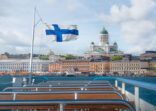Easy monetary policies adopted by major central banks across the world have helped the global economic recovery stay mainly on track, with key markets getting some benefits from the plunge in oil prices.
In this environment, equities seem to be getting more attention. Baring Asset Management in its ten-year investment outlook said equities will be the best performing asset class and the UK, Japan and to some extent emerging markets will likely be the standout markets over the next decade.
Global equity product launch plans from HSBC Global Asset Management and Capital Group show that fund houses see opportunity in the world’s stock markets.
But not all is rosy. A recent bi-annual “Spot the Dog” report by the UK-based Tilney Bestinvest said most global equity funds underperformed their benchmark index.
Amid these developments, FSA takes a look at the Fidelity World Fund and the Nordea 1 Global Stable Equity Fund Unhedged.
While both funds look for equity investment opportunities across the world, there is a significant difference in their investment approach.
Luke Ng, senior vice president at FE Advisory Asia, has provided a comparative analysis.
Investment strategy review
The Fidelity fund adopts a bottom-up stock selection approach and has a strong focus on fundamental research of individual stocks, said Ng.
Jeremy Podger, the portfolio manager, classifies companies into three categories: a) change: companies that could undergo near-term restructuring such as a merger or spin-off, b) value: businesses that are able to deliver earnings growth that exceed expectations, and c) franchise: firms which have a dominant industry position, with strong cash flows, pricing power and growth, said Ng.
“In normal circumstances, stocks with ‘change’ and ‘franchise’ prospects usually make up 15-30% each of the portfolio exposure, and ‘value’ usually makes up for the remainder,” said Ng.
The Nordea team by comparison attempts to look for companies that operate in established lines of businesses and can generate stable earnings, dividends and cash flows.
“These equities are often regarded as `boring stocks’ that attract less attention from investors and public in general,” said Ng.
“The Nordea team relies heavily on quantitative screening for portfolio construction.”
It uses a quantitative screening process to identify stocks offering good risk/reward prospects based on factors such as price, earnings, dividends and cash flow.
“After the initial screening, standardised questionnaires are sent out to shortlisted companies. The questionnaires cover financial projection, financial health and any other variable that the fund manager would like to consider.”
These forward-looking ideas help in the portfolio construction process.
In terms of arriving at sale decisions, both firms do it differently. Podger, the Fidelity fund manager, sets target prices and is also willing to sell stocks when there is a significant change in the risk-reward balance.
The Nordea team does not set target prices for their holdings. They arrive at a sell decision when stock prices rise above the team’s fair value projection, said Ng.
Overall, the Fidelity fund typically holds 50-90 stocks in the portfolio, while the Nordea team intends to build a portfolio of around 100 stable stocks.
Both funds have a strong focus on the US, followed by Japan and developed European countries.
But given the different investment philosophies and processes, the top 10 holdings of the two funds also differ, as seen in the portfolio allocation table:

 Source: Fund fact sheets on 30 June
Source: Fund fact sheets on 30 June














